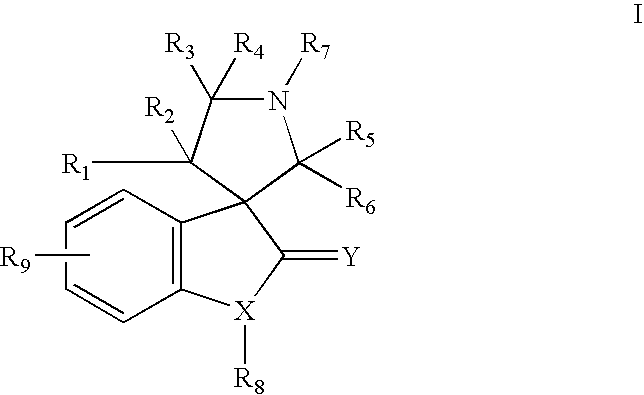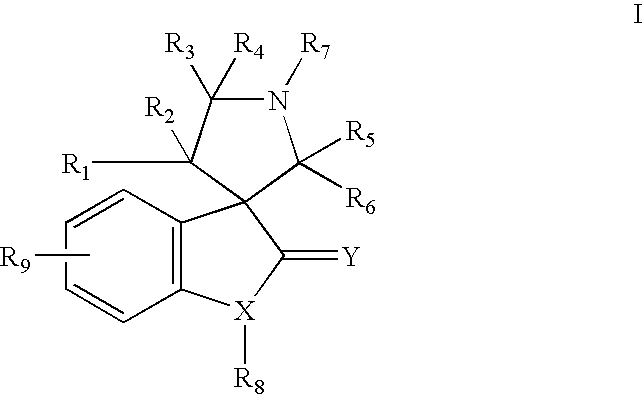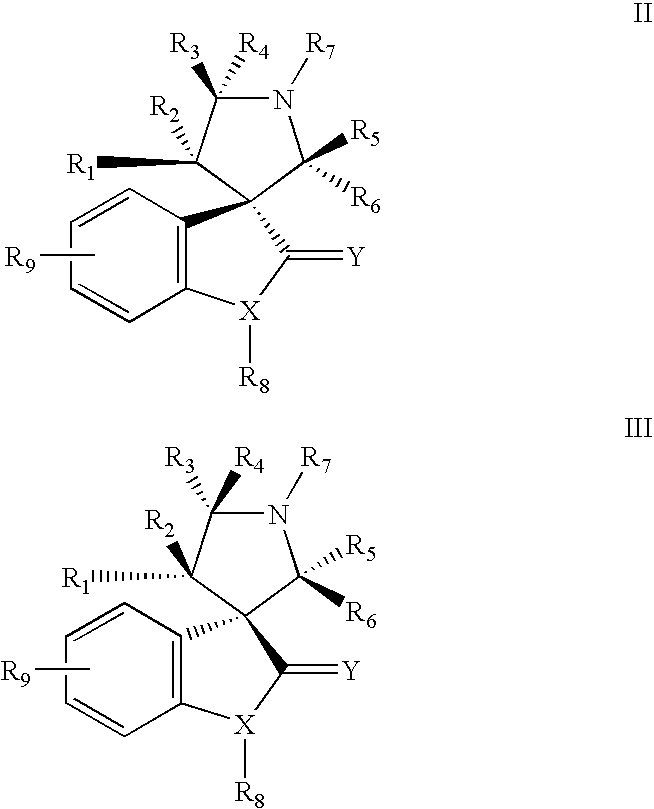New small molecule inhibitors of mdm2 and the uses thereof
a small molecule inhibitor and inhibitor technology, applied in the field of new small molecule inhibitors of mdm2, can solve the problems of poor cell permeability and in vivo bioavailability, poor drug-like molecules of inhibitors, and high throughput screening strategies that have had very limited success in identifying potent, non-peptide small molecule inhibitors. , to achieve the effect of increasing the function(s) of p53, prolonging the half-life of p53,
- Summary
- Abstract
- Description
- Claims
- Application Information
AI Technical Summary
Benefits of technology
Problems solved by technology
Method used
Image
Examples
example 1
6-CHLORO-4′-(3-CHLORO-PHENYL)-2′-(2,2-DIMETHYL-PROPYL)-5-FLUORO-2-OXO-1,2-DIHYDRO-SPIRO[INDOLE-3,3′-PYRROLIDINE]-5′-CARBOXYLIC ACID (3,4-DIHYDROXY-BUTYL)-AMIDE
[0118]
[0119]1H NMR (300 MHz, CD3OH), δ 7.70 (d, 1H, J=8.4 Hz), 7.40-7.20 (m, 3H), 7.09 (m, 1H), 6.88 (d, 1H, J=6.0 Hz), 5.22 (d, 1H, J=11.4 Hz), 4.39 (m, 1H), 4.11 (d, 1H, J=11.1 Hz), 3.65-3.32 (m, 9H), 1.85 (m, 1H), 1.60 (m, 1H), 1.41 (m, 1H), 1.19 (m, 1H), 0.84 (s, 9H).
example 2
6-CHLORO-4′-(3-CHLORO-PHENYL)-2′-(2,2-DIMETHYL-PROPYL)-5-FLUORO-2-OXO-1,2-DIHYDRO-SPIRO[INDOLE-3,3′-PYRROLIDINE]-5′-CARBOXYLIC ACID (2,3-DIHYDROXY-PROPYL)-AMIDE
[0120]
[0121]1H NMR (300 MHz, CD3OH), δ 7.74 (d, 1H, J=7.5 Hz), 7.35-7.15 (m, 3H), 7.11 (m, 1H), 6.88 (d, 1H, J=6.0 Hz), 5.22 (d, 1H, J=11.4 Hz), 4.33 (m, 1H), 4.28 (d, 1H, J=10.5 Hz), 3.67 (m, 2H), 3.65-3.32 (m, 4H), 2.05 (m, 1H), 1.90 (m, 1H), 1.56 (m, 1H), 0.87 (s, 9H).
example 3
6-CHLORO-4′-(3-CHLORO-PHENYL)-2′-(2,2-DIMETHYL-PROPYL)-5-FLUORO-2-OXO-1,2-DIHYDRO-SPIRO[INDOLE-3,3′-PYRROLIDINE]-5′-CARBOXYLIC ACID (3,5-DIHYDROXY-PENTYL)-AMIDE
[0122]
[0123]1H NMR (300 MHz, CD3OH), δ 7.72 (d, 1H, J=8.4 Hz), 7.35-7.15 (m, 3H), 7.10 (m, 1H), 6.88 (d, 1H, J=6.0 Hz), 5.23 (d, 1H, J=11.1 Hz), 4.65 (m, 1H), 4.13 (d, 1H, J=11.4 Hz), 3.61 (m, 2H), 3.65-3.32 (m, 5H), 2.02 (m, 1H), 1.93 (m, 1H), 1.56 (m, 3H), 1.15 (m, 1H), 0.92 (s, 9H).
PUM
| Property | Measurement | Unit |
|---|---|---|
| temperature | aaaaa | aaaaa |
| concentration | aaaaa | aaaaa |
| pH | aaaaa | aaaaa |
Abstract
Description
Claims
Application Information
 Login to View More
Login to View More - R&D
- Intellectual Property
- Life Sciences
- Materials
- Tech Scout
- Unparalleled Data Quality
- Higher Quality Content
- 60% Fewer Hallucinations
Browse by: Latest US Patents, China's latest patents, Technical Efficacy Thesaurus, Application Domain, Technology Topic, Popular Technical Reports.
© 2025 PatSnap. All rights reserved.Legal|Privacy policy|Modern Slavery Act Transparency Statement|Sitemap|About US| Contact US: help@patsnap.com



